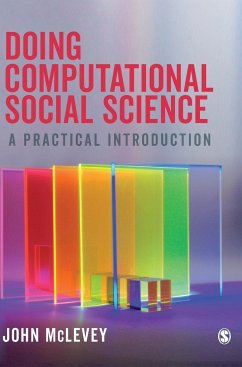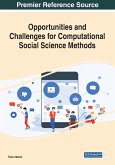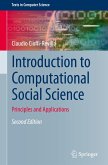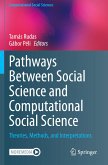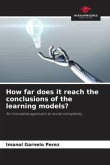- Gebundenes Buch
- Merkliste
- Auf die Merkliste
- Bewerten Bewerten
- Teilen
- Produkt teilen
- Produkterinnerung
- Produkterinnerung
Computational approaches offer exciting opportunities for us to do social science differently. This beginner's guide discusses a range of computational methods and how to use them to study the problems and questions you want to research.
Andere Kunden interessierten sich auch für
![Opportunities and Challenges for Computational Social Science Methods Opportunities and Challenges for Computational Social Science Methods]() Opportunities and Challenges for Computational Social Science Methods173,99 €
Opportunities and Challenges for Computational Social Science Methods173,99 €![Opportunities and Challenges for Computational Social Science Methods Opportunities and Challenges for Computational Social Science Methods]() Opportunities and Challenges for Computational Social Science Methods223,99 €
Opportunities and Challenges for Computational Social Science Methods223,99 €![Introduction to Computational Social Science Introduction to Computational Social Science]() Claudio Cioffi-RevillaIntroduction to Computational Social Science91,99 €
Claudio Cioffi-RevillaIntroduction to Computational Social Science91,99 €![Pathways Between Social Science and Computational Social Science Pathways Between Social Science and Computational Social Science]() Pathways Between Social Science and Computational Social Science69,54 €
Pathways Between Social Science and Computational Social Science69,54 €![Social Science Research Social Science Research]() Barbara CzarniawskaSocial Science Research192,99 €
Barbara CzarniawskaSocial Science Research192,99 €![Arwi or Arabu-Tamil in the Digital Age Arwi or Arabu-Tamil in the Digital Age]() K M A Ahamed ZubairArwi or Arabu-Tamil in the Digital Age17,99 €
K M A Ahamed ZubairArwi or Arabu-Tamil in the Digital Age17,99 €![How far does it reach the conclusions of the learning models? How far does it reach the conclusions of the learning models?]() Imanol Garnelo PerezHow far does it reach the conclusions of the learning models?29,99 €
Imanol Garnelo PerezHow far does it reach the conclusions of the learning models?29,99 €-
-
-
Computational approaches offer exciting opportunities for us to do social science differently. This beginner's guide discusses a range of computational methods and how to use them to study the problems and questions you want to research.
Hinweis: Dieser Artikel kann nur an eine deutsche Lieferadresse ausgeliefert werden.
Hinweis: Dieser Artikel kann nur an eine deutsche Lieferadresse ausgeliefert werden.
Produktdetails
- Produktdetails
- Verlag: SAGE Publications Ltd
- Seitenzahl: 688
- Erscheinungstermin: 25. Dezember 2021
- Englisch
- Abmessung: 250mm x 175mm x 41mm
- Gewicht: 1347g
- ISBN-13: 9781526468192
- ISBN-10: 1526468190
- Artikelnr.: 62074530
- Herstellerkennzeichnung
- Libri GmbH
- Europaallee 1
- 36244 Bad Hersfeld
- gpsr@libri.de
- Verlag: SAGE Publications Ltd
- Seitenzahl: 688
- Erscheinungstermin: 25. Dezember 2021
- Englisch
- Abmessung: 250mm x 175mm x 41mm
- Gewicht: 1347g
- ISBN-13: 9781526468192
- ISBN-10: 1526468190
- Artikelnr.: 62074530
- Herstellerkennzeichnung
- Libri GmbH
- Europaallee 1
- 36244 Bad Hersfeld
- gpsr@libri.de
John McLevey is an Associate Professor in the Department of Knowledge Integration at the University of Waterloo (ON, Canada). He is also appointed to the Departments of Sociology & Legal Studies and Geography and Environmental Management, is a Policy Fellow at the Balsillie School of International Affairs, and a Member of the Cybersecurity and Privacy Institute at the University of Waterloo. His work is funded by research grants from the Social Science and Humanities Research Council of Canada (SSHRC) and an Early Researcher Award from the Ontario Ministry of Research and Innovation. His current research project focuses on disinformation, censorship, and political deliberation in the public sphere across a wide variety of national contexts and political regimes. He wrote Doing Computational Social Science (SAGE Publishing, 2021) from his experiences as a researcher and advisor, as well as teaching courses in computational social science, data science, and research methods to students from diverse disciplinary backgrounds at the undergraduate and graduate level.
Introduction: Learning to do computational social science
Part I: Foundations
Chapter 1: Setting up your open source scientific computing environment
Chapter 2: Python programming: The basics
Chapter 3: Python programming: Data structures, functions and files
Chapter 4: Collecting data from Application Programming Interfaces (APIs)
Chapter 5: Collecting data from the web: Scraping
Chapter 6: Processing structured data
Chapter 7: Visualisation and exploratory data analysis
Chapter 8: Latent factors and components
Part II: Fundamentals of text analysis
Chapter 9: Processing natural language data
Chapter 10: Iterative text analysis
Chapter 11: Exploratory text analysis
Chapter 12: Text similarity and latent semantic space
Part III: Fundamentals of network analysis
Chapter 13: Social networks and relational thinking
Chapter 14: Connection and clustering in social networks
Chapter 15: Influence, inequality and power in social networks
Chapter 16: Going viral: Modelling the epidemic spread of simple contagions
Chapter 17: Not so fast: Modelling the diffusion of complex contagions
Part IV: Research ethics and machine learning
Chapter 18: Research ethics, politics and practices
Chapter 19: Machine learning: Symbolic and connectionist
Chapter 20: Supervised learning with regression and cross-validation
Chapter 21: Supervised learning with tree-based models
Chapter 22: Neural networks and deep learning
Chapter 23: Developing neural network models with Keras and Tensorflow
Part V: Bayesian machine learning and probabilistic programming
Chapter 24: Statistical machine learning and generative models
Chapter 25: Probability: A primer
Chapter 26: Approximate posterior inference with stochastic sampling and
MCMC
Part VI: Bayesian data analysis and latent variable modelling with
relational and text data
Chapter 27: Bayesian regression models with probabilistic programming
Chapter 28: Bayesian hierarchical regression modelling
Chapter 29: Variational Bayes and the craft of generative topic modelling
Chapter 30: Generative network analysis with Bayesian stochastic
blockmodels
Part VII: Embeddings, transformer models and named entity recognition
Chapter 31: Can we model meaning?: Contextual representation and neural
word embeddings
Chapter 32: Named entity recognition, transfer learning and transformer
models
Part I: Foundations
Chapter 1: Setting up your open source scientific computing environment
Chapter 2: Python programming: The basics
Chapter 3: Python programming: Data structures, functions and files
Chapter 4: Collecting data from Application Programming Interfaces (APIs)
Chapter 5: Collecting data from the web: Scraping
Chapter 6: Processing structured data
Chapter 7: Visualisation and exploratory data analysis
Chapter 8: Latent factors and components
Part II: Fundamentals of text analysis
Chapter 9: Processing natural language data
Chapter 10: Iterative text analysis
Chapter 11: Exploratory text analysis
Chapter 12: Text similarity and latent semantic space
Part III: Fundamentals of network analysis
Chapter 13: Social networks and relational thinking
Chapter 14: Connection and clustering in social networks
Chapter 15: Influence, inequality and power in social networks
Chapter 16: Going viral: Modelling the epidemic spread of simple contagions
Chapter 17: Not so fast: Modelling the diffusion of complex contagions
Part IV: Research ethics and machine learning
Chapter 18: Research ethics, politics and practices
Chapter 19: Machine learning: Symbolic and connectionist
Chapter 20: Supervised learning with regression and cross-validation
Chapter 21: Supervised learning with tree-based models
Chapter 22: Neural networks and deep learning
Chapter 23: Developing neural network models with Keras and Tensorflow
Part V: Bayesian machine learning and probabilistic programming
Chapter 24: Statistical machine learning and generative models
Chapter 25: Probability: A primer
Chapter 26: Approximate posterior inference with stochastic sampling and
MCMC
Part VI: Bayesian data analysis and latent variable modelling with
relational and text data
Chapter 27: Bayesian regression models with probabilistic programming
Chapter 28: Bayesian hierarchical regression modelling
Chapter 29: Variational Bayes and the craft of generative topic modelling
Chapter 30: Generative network analysis with Bayesian stochastic
blockmodels
Part VII: Embeddings, transformer models and named entity recognition
Chapter 31: Can we model meaning?: Contextual representation and neural
word embeddings
Chapter 32: Named entity recognition, transfer learning and transformer
models
Introduction: Learning to do computational social science
Part I: Foundations
Chapter 1: Setting up your open source scientific computing environment
Chapter 2: Python programming: The basics
Chapter 3: Python programming: Data structures, functions and files
Chapter 4: Collecting data from Application Programming Interfaces (APIs)
Chapter 5: Collecting data from the web: Scraping
Chapter 6: Processing structured data
Chapter 7: Visualisation and exploratory data analysis
Chapter 8: Latent factors and components
Part II: Fundamentals of text analysis
Chapter 9: Processing natural language data
Chapter 10: Iterative text analysis
Chapter 11: Exploratory text analysis
Chapter 12: Text similarity and latent semantic space
Part III: Fundamentals of network analysis
Chapter 13: Social networks and relational thinking
Chapter 14: Connection and clustering in social networks
Chapter 15: Influence, inequality and power in social networks
Chapter 16: Going viral: Modelling the epidemic spread of simple contagions
Chapter 17: Not so fast: Modelling the diffusion of complex contagions
Part IV: Research ethics and machine learning
Chapter 18: Research ethics, politics and practices
Chapter 19: Machine learning: Symbolic and connectionist
Chapter 20: Supervised learning with regression and cross-validation
Chapter 21: Supervised learning with tree-based models
Chapter 22: Neural networks and deep learning
Chapter 23: Developing neural network models with Keras and Tensorflow
Part V: Bayesian machine learning and probabilistic programming
Chapter 24: Statistical machine learning and generative models
Chapter 25: Probability: A primer
Chapter 26: Approximate posterior inference with stochastic sampling and
MCMC
Part VI: Bayesian data analysis and latent variable modelling with
relational and text data
Chapter 27: Bayesian regression models with probabilistic programming
Chapter 28: Bayesian hierarchical regression modelling
Chapter 29: Variational Bayes and the craft of generative topic modelling
Chapter 30: Generative network analysis with Bayesian stochastic
blockmodels
Part VII: Embeddings, transformer models and named entity recognition
Chapter 31: Can we model meaning?: Contextual representation and neural
word embeddings
Chapter 32: Named entity recognition, transfer learning and transformer
models
Part I: Foundations
Chapter 1: Setting up your open source scientific computing environment
Chapter 2: Python programming: The basics
Chapter 3: Python programming: Data structures, functions and files
Chapter 4: Collecting data from Application Programming Interfaces (APIs)
Chapter 5: Collecting data from the web: Scraping
Chapter 6: Processing structured data
Chapter 7: Visualisation and exploratory data analysis
Chapter 8: Latent factors and components
Part II: Fundamentals of text analysis
Chapter 9: Processing natural language data
Chapter 10: Iterative text analysis
Chapter 11: Exploratory text analysis
Chapter 12: Text similarity and latent semantic space
Part III: Fundamentals of network analysis
Chapter 13: Social networks and relational thinking
Chapter 14: Connection and clustering in social networks
Chapter 15: Influence, inequality and power in social networks
Chapter 16: Going viral: Modelling the epidemic spread of simple contagions
Chapter 17: Not so fast: Modelling the diffusion of complex contagions
Part IV: Research ethics and machine learning
Chapter 18: Research ethics, politics and practices
Chapter 19: Machine learning: Symbolic and connectionist
Chapter 20: Supervised learning with regression and cross-validation
Chapter 21: Supervised learning with tree-based models
Chapter 22: Neural networks and deep learning
Chapter 23: Developing neural network models with Keras and Tensorflow
Part V: Bayesian machine learning and probabilistic programming
Chapter 24: Statistical machine learning and generative models
Chapter 25: Probability: A primer
Chapter 26: Approximate posterior inference with stochastic sampling and
MCMC
Part VI: Bayesian data analysis and latent variable modelling with
relational and text data
Chapter 27: Bayesian regression models with probabilistic programming
Chapter 28: Bayesian hierarchical regression modelling
Chapter 29: Variational Bayes and the craft of generative topic modelling
Chapter 30: Generative network analysis with Bayesian stochastic
blockmodels
Part VII: Embeddings, transformer models and named entity recognition
Chapter 31: Can we model meaning?: Contextual representation and neural
word embeddings
Chapter 32: Named entity recognition, transfer learning and transformer
models

